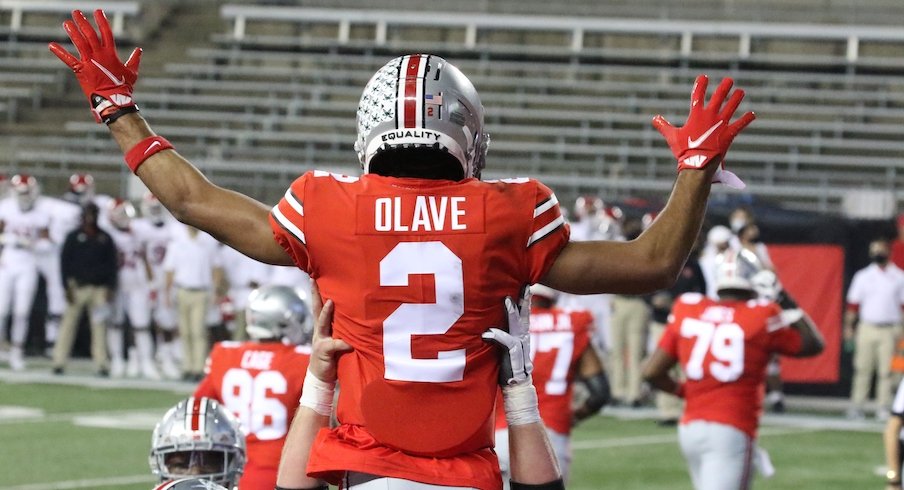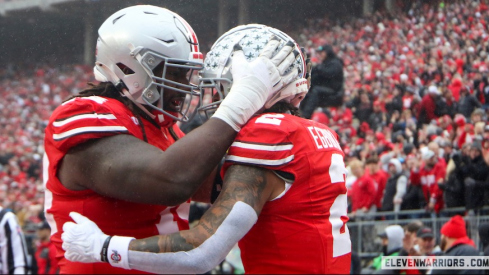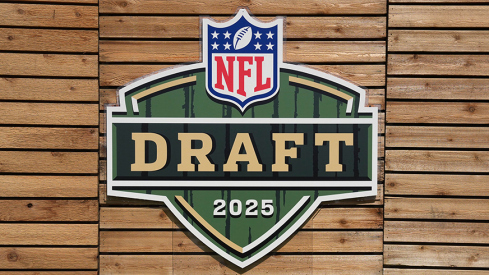Ohio State didn’t have a 3,000-yard passer, 1,000-yard rusher or 1,000-yard receiver in 2020. The Buckeyes almost certainly would have, though, if they had played anything close to a full season.
Because the Buckeyes played only eight games, their stars didn’t have the opportunity to put up huge individual numbers for the 2020 season. But if they had played 12 regular-season games instead of just five, and still made it to the national championship game for a full 15 games, players like Justin Fields, Trey Sermon, Chris Olave and Garrett Wilson would have been on pace to have some of the more prolific seasons in Ohio State history at their respective positions.
With that in mind, we’ve run the numbers to take a look at what each of their statistics for 2020 could have been if COVID-19 – and the Big Ten’s decision not to start the season until late October – hadn’t limited Ohio State to its shortest season since 1941.
Since I wasn’t a math major, we’re keeping the calculations simple. Each player’s projected stats for if there had been a full 2020 season were determined by multiplying their per-game statistics for the games that they did play by 15, the number of games the Buckeyes would have played if they had a full regular season and still made it all the way to the College Football Playoff final.
Certainly there are other variables that could be factored into this equation, like the fact that these players might not have played as many snaps per game as they did if there were 15 games played, and the competitive differences between the opponents they did play (including Alabama and Clemson in the College Football Playoff) and the opponents they would have played (including non-conference games against Bowling Green, Oregon and Buffalo).
For this hypothetical, though, we’re assuming that everything would have equated out over the course of a 15-game season. In this idyllic hypothetical world, we’re also pretending as though players wouldn't have missed time for COVID-19, so players like Olave who missed time due to positive tests still get their stats projected for a full 15-game season.
QB Justin Fields
| Pass Comp | Pass Att | Pass Yds | Pass TD | INT | Rush Att | Rush Yds | Rush TD | |
|---|---|---|---|---|---|---|---|---|
| ACTUAL STATS (8 GAMES) | 158 | 225 | 2,100 | 22 | 6 | 81 | 383 | 5 |
| PROJECTED 15-GAME STATS | 296 | 422 | 3,938 | 41 | 11 | 152 | 718 | 9 |
Fields broke one single-season Ohio State record this year by completing 70.2 percent of his passes, breaking the previous mark of 70.0 percent by Dwayne Haskins in 2018. While he likely wouldn’t have broken Haskins’ single-season records of 4,831 passing yards and 50 passing touchdowns, he was on pace for one of the most statistically prolific seasons in Ohio State history if he had been able to play a full season.
The second-year Ohio State starter averaged nearly 30 more passing yards per game in 2020 (262.5) than in 2019 (233.8), and if he had continued that pace over 15 games, he would have easily had the second-most single-season passing yards in school history, surpassing Joe Germaine’s second-place total of 3,330 yards. Fields was also on pace to tie his 41 passing touchdowns from last year, which is already the second-highest total in Ohio State history.
In total, Fields was on pace for 4,656 yards of total offense, which would have also been the second-most in Ohio State history. He also averaged over 13 more rushing yards per game in 2020 (47.9) than 2019 (34.6).
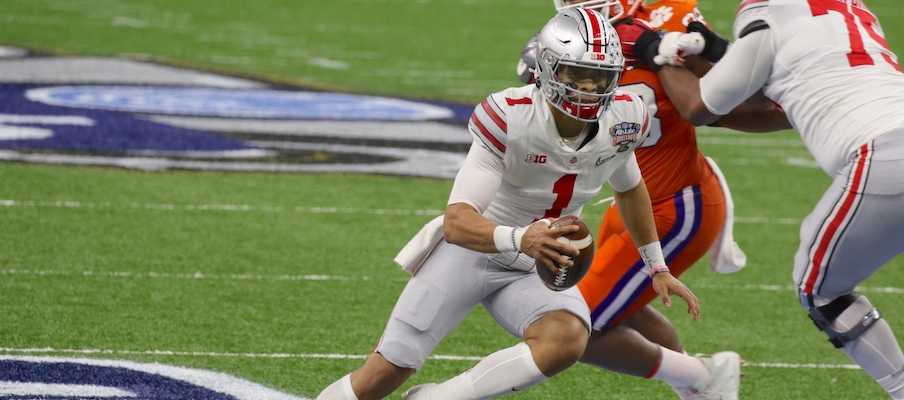
RB Trey Sermon
| Rush Att | Rush Yds | Rush TD | Rec | Rec Yds | |
|---|---|---|---|---|---|
| ACTUAL STATS (8 GAMES) | 116 | 870 | 4 | 12 | 95 |
| PROJECTED 15-GAME STATS | 218 | 1,631 | 8 | 23 | 178 |
Sermon’s production was all over the place in Ohio State’s eight-game season, as he never topped 68 rushing yards in any of the Buckeyes’ first four games, then had three straight triple-digit rushing games – including a school-record 331 rushing yards in the Big Ten Championship Game against Northwestern – before suffering an injury on his very first carry in the national championship game and finishing that game with just two rushing yards.
It’s unlikely that 331-yard performance would have been repeated no matter how many additional games Ohio State played, as that happened in part because of Master Teague being injured, but a full season would have also meant the opportunity to play more games after working through the early-season kinks. If we just assume everything averaging out and Sermon producing at those averages over seven additional games, that would have been enough for a huge season.
A projected total of 1,631 rushing yards over a 15-game season would have been enough for the seventh-most single-season rushing yards in Ohio State history. A projected total of 1,809 all-purpose yards would have been the ninth-most in school history.
WR Chris Olave
| Rec | Rec Yds | Rec TD | |
|---|---|---|---|
| ACTUAL STATS (7 GAMES) | 50 | 729 | 7 |
| PROJECTED 15-GAME STATS | 107 | 1,562 | 15 |
No Ohio State wide receiver has ever caught more than 90 passes in a single season (Parris Campbell in 2018), so Olave – who had more catches in just seven games than the 49 he had in 14 games in 2019 – was on pace to blow by that record if he and the Buckeyes had been able to play a full 2020 season.
Likewise, Olave was also on pace to break David Boston’s school record of 1,435 yards (1998), while he wasn’t far off the pace from Terry Glenn’s school record of 17 receiving touchdowns in 1995.
If Olave heads to the NFL, he’ll finish his three-year Ohio State career with 22 actual touchdowns, good for sixth in school history. If he had actually been able to catch 15 touchdown passes this year, he would have tied Devin Smith for second in school history with 30 career touchdowns.
WR Garrett Wilson
| Rec | Rec Yds | Rec TD | |
|---|---|---|---|
| ACTUAL STATS (8 GAMES) | 43 | 723 | 6 |
| PROJECTED 15-GAME STATS | 81 | 1,356 | 11 |
Ohio State has never had two 1,000-yard receivers in the same season, but 2020 likely would have been the year if the Buckeyes had played a full slate. Wilson finished Ohio State’s eight-game season on a 15-game pace of 1,356 yards, which would have been the third-most in school history (not including Olave’s projected total).
Wilson was on pace for the third-most receptions in school history (again, not including Olave’s projected total) and to become the 12th receiver in Ohio State history to catch at least 11 touchdown passes in a season.
Wilson will get another chance to have a season for the record books in 2021, as he’ll be back for one more season with the Buckeyes and will enter next season as Ohio State’s clear No. 1 receiver if Olave goes pro.
TE Jeremy Ruckert
| Rec | Rec Yds | Rec TD | |
|---|---|---|---|
| ACTUAL STATS (8 GAMES) | 13 | 151 | 5 |
| PROJECTED 15-GAME STATS | 24 | 283 | 9 |
Ohio State tight ends typically don’t put up big numbers, and at least in terms of catches and yards, that was the case once again for Ruckert, the Buckeyes’ leading receiver at tight end in 2020. Even when his numbers are projected out over a 15-game season, Ruckert wasn’t on pace to reach 25 catches or 300 yards.
He did catch five touchdown passes, though, and would have been on pace to break the school mark for receiving touchdowns by a tight end in a full season. No Ohio State tight end has ever had more than seven receiving touchdowns in a single season.
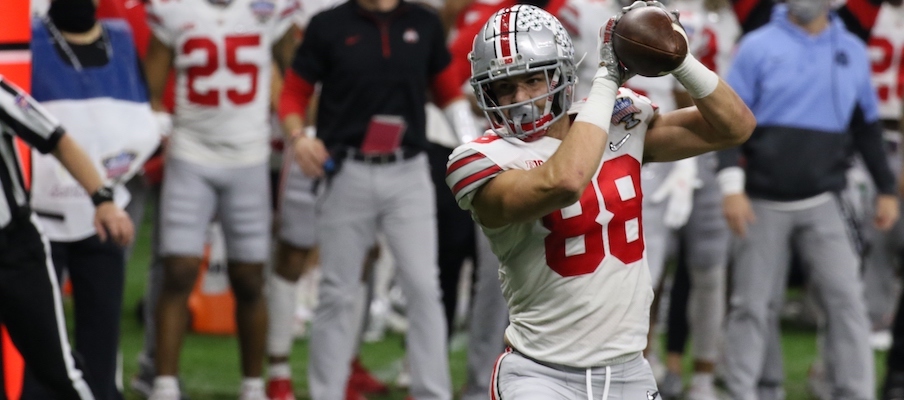
DE Jonathon Cooper
| Tackles | Sacks | FF | |
|---|---|---|---|
| ACTUAL STATS (8 GAMES) | 24 | 3.5 | 1 |
| PROJECTED 15-GAME STATS | 45 | 6.5 | 2 |
Ohio State didn’t have anything close to a Chase Young-level pass-rusher this past season, but Cooper was the Buckeyes’ most productive defensive end, leading the team with 3.5 sacks and leading all defensive linemen with 24 total tackles.
While his projected numbers for a 15-game season don’t jump off the page, they are solid. He only had 6.5 sacks in his entire Ohio State career before 2020, so he could have matched that total in his final season as a Buckeye, while he was on pace to come very close to matching Young’s 46 total tackles in 2019.
LB Pete Werner
| Tackles | TFL | FF | |
|---|---|---|---|
| ACTUAL STATS (8 GAMES) | 54 | 2.5 | 2 |
| PROJECTED 15-GAME STATS | 101 | 4.5 | 4 |
Werner finished Ohio State’s eight-game season as the Buckeyes’ leading tackler. If the Buckeyes had played a full 15 games, he would have been on pace to become the first Buckeye since Raekwon McMillan in 2016 to surpass 100 tackles in a single season.
By comparison, Ohio State did not have a single defender with more than 75 total tackles in its 14-game 2019 season.
LB Tuf Borland
| Tackles | TFL | |
|---|---|---|
| ACTUAL STATS (7 GAMES) | 48 | 3.5 |
| PROJECTED 15-GAME STATS | 103 | 7.5 |
Although Werner finished the 2020 season as Ohio State’s leader in tackles, Borland – who was among the players who missed the Michigan State game – finished the season with a slightly higher per-game average. Over 15 games, that average would have totaled 103 tackles for Borland, which would have been the most since 2015, when McMillan had 119 and Joshua Perry had 105.
Borland, who tied for fifth on the Buckeyes in tackles for loss this season, was also on pace for 7.5 tackles for loss in a 15-game year.
LB Justin Hilliard
| Tackles | TFL | INT | FF | |
|---|---|---|---|---|
| ACTUAL STATS (8 GAMES) | 33 | 5 | 1 | 1 |
| PROJECTED 15-GAME STATS | 83 | 12.5 | 2 | 2 |
Hilliard missed Ohio State’s season opener with an injury before missing the Buckeyes’ second game with a false positive for COVID-19, but given all the health issues he had to battle throughout his Ohio State career, we’re giving him a full 15-game projection here. And if he had been able to play a full, healthy season for the Buckeyes, he could have put up excellent numbers based upon how he performed in the six games he was able to play.
Hilliard led the Buckeyes with five tackles for loss and ranked fourth on the team with 33 total tackles despite playing in just six games and only starting three of them. Over a full 15-game season, those numbers would have projected up to 83 total tackles and 12.5 tackles for loss.
2020 was already the most productive season of Hilliard’s six-year Ohio State career by far, but it could have been even bigger if the Buckeyes were able to play a full season.
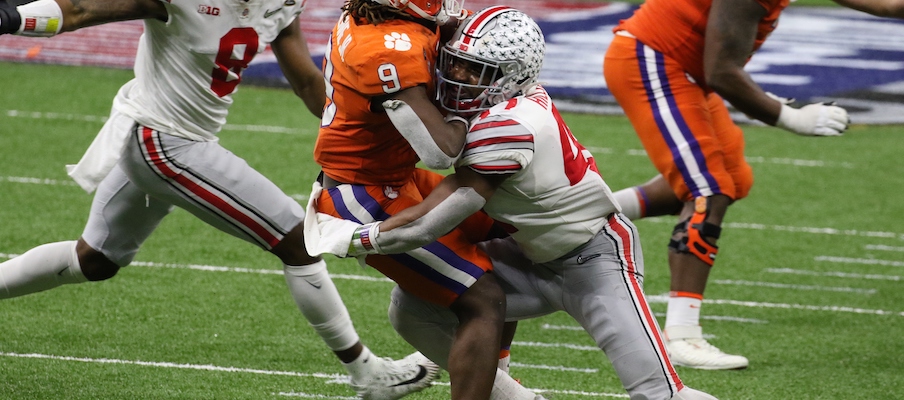
CB Shaun Wade
| Tackles | INT | PBU | |
|---|---|---|---|
| ACTUAL STATS (8 GAMES) | 35 | 2 | 4 |
| PROJECTED 15-GAME STATS | 66 | 4 | 8 |
Box-score statistics don’t really tell the story of a season for a defensive back, and when you look at statistics like how many catches, yards and touchdowns Wade allowed in 2020, he certainly didn’t have the kind of season he was expecting to have when he came back to Ohio State for one more year.
That said, Wade did lead all Ohio State defensive backs in tackles and all Buckeyes in interceptions this season. Projected out over the course of a 15-game season, Wade’s 66 total tackles would have been the most for an Ohio State cornerback since Bradley Roby had 69 in 2013.
Interceptions are a difficult statistic to project, but if Wade had been able to double his interception total by playing in twice as many games, he would have become the first Buckeye with four interceptions in a season since Damon Webb had five in 2017.
